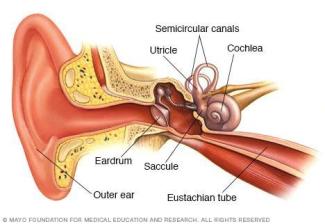
Physical Therapy for Benign Paroxysmal Positional Vertigo (BPPV)
BPPV is one of the most common causes of vertigo, the sudden sensation of feeling like you or your surroundings are spinning. This condition is a common problem with the inner ear that affects your vestibular system. The vestibular system is one of our sensory systems that provides the brain with information regarding head position, motion and spatial orientation. It is involved with functions that allow us to maintain balance and stabilize our body and head during movement. BPPV causes periods of dizziness when moving your head into certain positions.
Benign: the disorder is not life threatening
Paroxysmal: vertigo or spinning sensation occurs suddenly
Positional: onset of symptoms is triggered by head position Vertigo: spinning sensation
Inside of your inner ear there is a layer of calcium carbonate crystals (octonia) that are normally embedded in the utricle. In BPPV, these crystals become dislodged and travel to one of three semicircular canals. When enough crystals accumulate in one of these canals, they interfere with normal fluid movement in these canals and send false signals to the brain. When a person with BPPV moves their head in a certain way, the crystals move and cause the sensation of dizziness. Crystals can be knocked loose by several events including infection, Meniere’s Disease, head trauma or aging.
BPPV symptoms commonly occur during or after a change in one’s position. Vertigo/dizziness subsequently ensues and can last anywhere from 15-45 seconds. Movements that exacerbate symptoms can include turning in bed, lying down, looking up or bending over. Typically, these symptoms last less than one minute and include dizziness, vertigo, unsteadiness, poor balance, nausea or vomiting
An examination by our physical therapist (PT) will help identify and diagnose BPPV. During the exam, your PT will look for involuntary eye movement called nystagmus and ask if any motions cause vertigo. Your PT will use positional tests to provoke symptoms of BPPV. These tests involve specific head and body movements and are designed to move the crystals from the semicircular canals back to the utricle. Although they are designed to provoke symptoms, they will assist your PT in determining the cause of your symptoms and which maneuvers will be used for treatment.
For a large majority of people, BPPV treatment is successful with simple and specific maneuvers where you move your head and body in certain directions.
Unfortunately, there is no medication to cure or minimize the effects of BPPV. This condition can re-occur periodically, especially in patients whose BPPV is trauma-related. If symptoms occur in the same canal, your PT may show you maneuvers to perform on your own at home. Due to many variants of BPPV, the treatment maneuver that worked one time may not work for another episode.
For more information on BPPV, please visit the following links:
If you or a loved one are suffering from dizziness or vertigo, please contact your local Doctor of Physical Therapy for a full examination and assessment for BPPV. Begin the road to living the life you want. Physical Therapists improve the way you move!
Ryan Hastie, PT, DPT, CSCS Doctor of Physical Therapy
Certified Strength and Conditioning Specialist Titleist Performance Institute Medical 2 Certified

